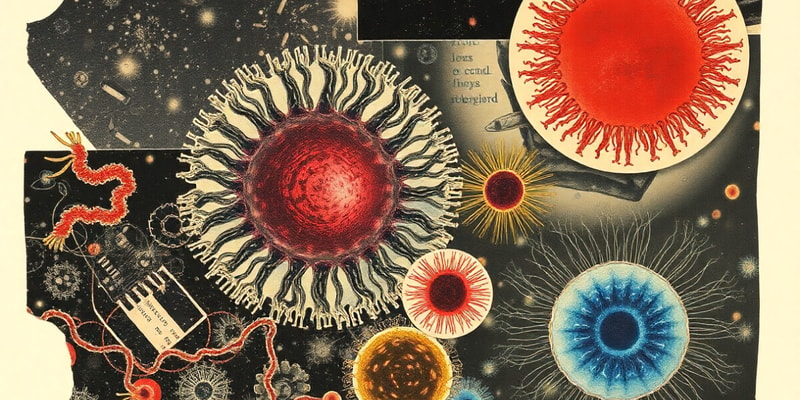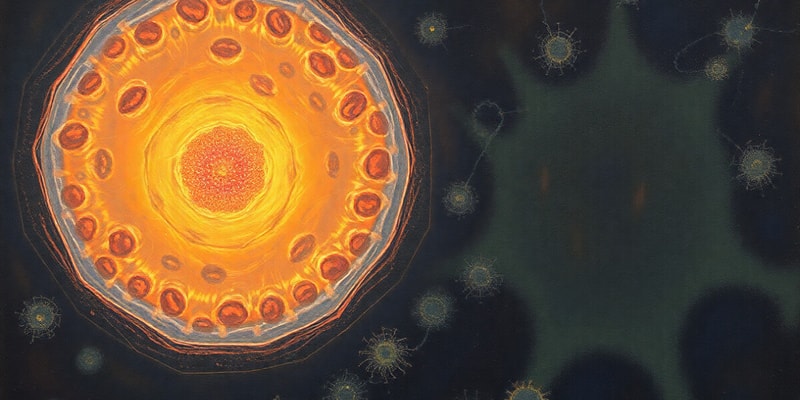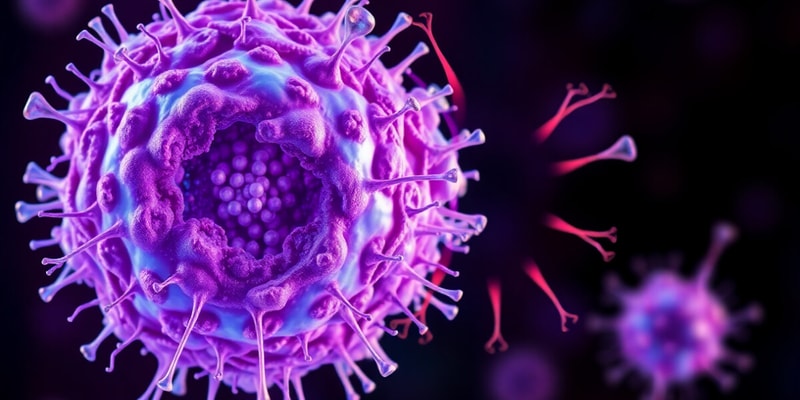Podcast
Questions and Answers
What is a defining characteristic of prokaryotic cells compared to eukaryotic cells?
What is a defining characteristic of prokaryotic cells compared to eukaryotic cells?
What is the main function of the glycocalyx in bacterial cells?
What is the main function of the glycocalyx in bacterial cells?
Which structure is responsible for protein synthesis in eukaryotic cells?
Which structure is responsible for protein synthesis in eukaryotic cells?
Which component distinguishes eukaryotic flagella from prokaryotic flagella?
Which component distinguishes eukaryotic flagella from prokaryotic flagella?
Signup and view all the answers
Which of the following structures is involved in intracellular digestion?
Which of the following structures is involved in intracellular digestion?
Signup and view all the answers
What is the primary role of mitochondria in a cell?
What is the primary role of mitochondria in a cell?
Signup and view all the answers
Which of the following is NOT a feature of eukaryotic cells?
Which of the following is NOT a feature of eukaryotic cells?
Signup and view all the answers
What defines a dimorphic organism?
What defines a dimorphic organism?
Signup and view all the answers
What is the first step in the process of viral multiplication?
What is the first step in the process of viral multiplication?
Signup and view all the answers
Which method allows a virus's genome to enter the host cell?
Which method allows a virus's genome to enter the host cell?
Signup and view all the answers
Which type of RNA must be converted into a positive message before translation?
Which type of RNA must be converted into a positive message before translation?
Signup and view all the answers
What is a characteristic of a latent virus?
What is a characteristic of a latent virus?
Signup and view all the answers
Which is NOT a method used to grow viruses in a lab?
Which is NOT a method used to grow viruses in a lab?
Signup and view all the answers
What are oncogenic viruses known for?
What are oncogenic viruses known for?
Signup and view all the answers
What is the role of reverse transcriptase?
What is the role of reverse transcriptase?
Signup and view all the answers
Which of the following is a form of viral release?
Which of the following is a form of viral release?
Signup and view all the answers
What is characteristic of capnophiles?
What is characteristic of capnophiles?
Signup and view all the answers
Which statement is true regarding positive sense RNA?
Which statement is true regarding positive sense RNA?
Signup and view all the answers
Which type of organism requires a large concentration of salt to survive?
Which type of organism requires a large concentration of salt to survive?
Signup and view all the answers
What characteristic defines a facultative aerobe?
What characteristic defines a facultative aerobe?
Signup and view all the answers
Which of the following is a defining feature of psychrophiles?
Which of the following is a defining feature of psychrophiles?
Signup and view all the answers
What distinguishes an obligate anaerobe from other types of anaerobes?
What distinguishes an obligate anaerobe from other types of anaerobes?
Signup and view all the answers
What is the main function of neuraminidase in the lifecycle of viruses?
What is the main function of neuraminidase in the lifecycle of viruses?
Signup and view all the answers
Which component is not considered a primary element found in microorganisms?
Which component is not considered a primary element found in microorganisms?
Signup and view all the answers
Which of the following describes a microaerophile?
Which of the following describes a microaerophile?
Signup and view all the answers
What type of microorganisms are helminths?
What type of microorganisms are helminths?
Signup and view all the answers
What best differentiates thermophiles from extremophiles?
What best differentiates thermophiles from extremophiles?
Signup and view all the answers
How do autotrophs obtain their carbon?
How do autotrophs obtain their carbon?
Signup and view all the answers
Which statement accurately describes the discovery of Salvarsan?
Which statement accurately describes the discovery of Salvarsan?
Signup and view all the answers
What best describes a broad-spectrum drug?
What best describes a broad-spectrum drug?
Signup and view all the answers
Which mechanism of action is primarily associated with alcohol as a disinfectant?
Which mechanism of action is primarily associated with alcohol as a disinfectant?
Signup and view all the answers
What defines a narrow-spectrum drug?
What defines a narrow-spectrum drug?
Signup and view all the answers
Which individual is credited with discovering penicillin?
Which individual is credited with discovering penicillin?
Signup and view all the answers
Which of the following types of organisms is an autotroph?
Which of the following types of organisms is an autotroph?
Signup and view all the answers
What structure is common to all viruses?
What structure is common to all viruses?
Signup and view all the answers
Which of the following components is NOT typically found in a fungal cell?
Which of the following components is NOT typically found in a fungal cell?
Signup and view all the answers
In what type of environment do both fungi and plants commonly thrive?
In what type of environment do both fungi and plants commonly thrive?
Signup and view all the answers
What is the first step in the process of protein manufacturing in a cell?
What is the first step in the process of protein manufacturing in a cell?
Signup and view all the answers
Which of the following statements about viruses is true?
Which of the following statements about viruses is true?
Signup and view all the answers
What is the significance of the replication process in viruses?
What is the significance of the replication process in viruses?
Signup and view all the answers
What is a characteristic that distinguishes fungi from plants?
What is a characteristic that distinguishes fungi from plants?
Signup and view all the answers
Which of the following viruses can infect the respiratory system?
Which of the following viruses can infect the respiratory system?
Signup and view all the answers
What are the optimum temperature ranges for mesophiles?
What are the optimum temperature ranges for mesophiles?
Signup and view all the answers
Which type of organism cannot survive in the presence of oxygen?
Which type of organism cannot survive in the presence of oxygen?
Signup and view all the answers
What is the primary source of carbon for autotrophs?
What is the primary source of carbon for autotrophs?
Signup and view all the answers
Which type of microorganism requires high concentrations of salt for survival?
Which type of microorganism requires high concentrations of salt for survival?
Signup and view all the answers
Which of the following statements accurately defines a microaerophile?
Which of the following statements accurately defines a microaerophile?
Signup and view all the answers
What distinguishes a thermophile from a general extremophile?
What distinguishes a thermophile from a general extremophile?
Signup and view all the answers
What type of nutrients do heterotrophs primarily depend on?
What type of nutrients do heterotrophs primarily depend on?
Signup and view all the answers
Where are barophiles likely to be found?
Where are barophiles likely to be found?
Signup and view all the answers
Which step involves the virus attaching to the host cell?
Which step involves the virus attaching to the host cell?
Signup and view all the answers
What are the methods of penetration by which a virus enters a host cell?
What are the methods of penetration by which a virus enters a host cell?
Signup and view all the answers
Which component is specifically responsible for synthesizing RNA from an RNA template?
Which component is specifically responsible for synthesizing RNA from an RNA template?
Signup and view all the answers
What kind of environment is typically used to cultivate viruses in a laboratory setting?
What kind of environment is typically used to cultivate viruses in a laboratory setting?
Signup and view all the answers
How is a latent virus characterized in relation to its behavior in a host?
How is a latent virus characterized in relation to its behavior in a host?
Signup and view all the answers
Which of the following is a feature of oncogenic viruses?
Which of the following is a feature of oncogenic viruses?
Signup and view all the answers
What is the final step of the viral multiplication process?
What is the final step of the viral multiplication process?
Signup and view all the answers
What is true regarding positive sense RNA in terms of viral replication?
What is true regarding positive sense RNA in terms of viral replication?
Signup and view all the answers
Which of the following structures is found in prokaryotic cells?
Which of the following structures is found in prokaryotic cells?
Signup and view all the answers
What is the primary function of a lysosome in a cell?
What is the primary function of a lysosome in a cell?
Signup and view all the answers
What is a key difference between eukaryotic and prokaryotic flagella?
What is a key difference between eukaryotic and prokaryotic flagella?
Signup and view all the answers
Which of the following statements about chloroplasts is correct?
Which of the following statements about chloroplasts is correct?
Signup and view all the answers
Which component of prokaryotic cells is responsible for protection against phagocytosis?
Which component of prokaryotic cells is responsible for protection against phagocytosis?
Signup and view all the answers
Which type of eukaryotic cell structure is primarily involved in protein modification and maturation?
Which type of eukaryotic cell structure is primarily involved in protein modification and maturation?
Signup and view all the answers
What is a characteristic feature of cilia compared to flagella?
What is a characteristic feature of cilia compared to flagella?
Signup and view all the answers
What distinguishes eukaryotic cells from prokaryotic cells regarding their organelles?
What distinguishes eukaryotic cells from prokaryotic cells regarding their organelles?
Signup and view all the answers
Study Notes
Review for Exam
- Cell Membrane: Eukaryotic cells have a cell membrane.
- Cell Wall: Plants, algae, fungi, and bacteria have a cell wall.
- Prokaryotic Cells: Lack a nucleus, have a nucleoid, cell wall (peptidoglycan), no membrane-bound organelles, and are typically unicellular.
- Eukaryotic Cells: Have a nucleus, membrane-bound organelles, and can be unicellular or multicellular. These organelles include the glycocalyx (protection), slime layer (protection from the environment), capsule (protection from phagocytosis), flagella (movement), and cilia (motility).
Cellular Structures and Functions
- Glycocalyx: Outer layer providing protection, attachment, and adhesion from phagocytosis. Composed of glycolipids, glycoproteins, and exopolysaccharides.
- Slime Layer: Loosely attached, protecting bacteria from the environment.
- Capsule: Tightly attached, protecting the cell from phagocytosis.
- Flagella: Long, sheathed cylinders with microtubules in a 9+2 arrangement, responsible for motility, feeding, and filtering (eukaryotic flagella are thicker than prokaryotic ones).
- Cilia: Smaller than flagella, more numerous, and involved in motility, feeding, and filtering. Only found in certain animal cells and protozoa.
- Lysosomes: Intracellular digestion (contain enzymes from the Golgi apparatus).
- Algae: Photosynthetic, have chlorophyll, a cell wall, and tissues, and can reproduce both sexually and asexually.
- Mitochondria: Site of ATP production (powerhouse of the cell).
- Chloroplasts: Site of photosynthesis in plant cells and algae.
- Nucleus: Contains genetic material (DNA) and controls cell activities.
- Endoplasmic Reticulum (ER): Two types (RER and SER), involved in protein synthesis and lipid storage.
- Golgi Apparatus: Modifies, sorts, and packages proteins for secretion.
Fungi Characteristics
- Unicellular and Multicellular: Fungi can exist in both forms.
- Cell Wall: Fungi have a rigid cell wall with a thick inner and thin outer layer (made of chitin).
- Heterotrophic: Obtain nutrients from other organisms.
- Two Types of Fungi: Yeasts (round and reproduce asexually) and Hyphae (long and filamentous).
- Reproduction: Primarily through the formation of spores on reproductive hyphae. This includes asexual and sexual reproduction.
Bacteria Information
- Characteristics: Prokaryotic, no nucleus or membrane-bound organelles, and reproduce by themselves (binary fission). They adapt to various environments.
- Heterotrophs & Autotrophs: Obtain nutrients from other organisms (heterotrophs) or use carbon dioxide as a food source (autotrophs) or use photosynthesis (phototrophs).
Virus Characteristics
- Non-cellular: Not considered cells, depend on a host cell for replication.
- Obligate Intracellular Parasites: Need a host cell for replication. Have either DNA or RNA, but never both. Covered by a capsid (protein coat), and sometimes an envelope.
- Parts of a Virus: DNA or RNA, protein, capsid, sometimes an envelope.
- Replication: Viruses infect cells, then take over the cellular functions to make new viruses.
Microorganism Growth and Control
-
Asexual Reproduction: Involves the production of new organisms from one parent
-
Sexual Reproduction: Involves the fusion of genetic material with two parents
-
Methods of Control:
-
Physical methods: Heat (dry and moist), radiation, filtration
-
Chemical Methods: Alcohols, halogens, phenols, and high-level germicides.
Antibiotic Classification and Drug Modes of Action
- Broad-spectrum drugs: Effective against a wide range of microbial types (e.g., gram-positive and gram-negative bacteria).
- Narrow-spectrum drugs: Effective against a limited range of microbial types.
- Antiseptic Drugs : slow or stop bacterial growth on external surfaces
Studying That Suits You
Use AI to generate personalized quizzes and flashcards to suit your learning preferences.
Related Documents
Description
This quiz focuses on the structure and function of cellular components, including differences between prokaryotic and eukaryotic cells, as well as specific structures like the glycocalyx, slime layer, capsule, and flagella. Prepare effectively for your exam with these key concepts in cell biology.




